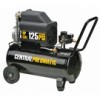Harbor Freight Tools 67501 User Manual - Page 4
allow persons unfamiliar with
 |
View all Harbor Freight Tools 67501 manuals
Add to My Manuals
Save this manual to your list of manuals |
Page 4 highlights
matching outlets will reduce risk of electric shock. b.Do not expose the compressor to rain or wet conditions. Water entering a compressor will increase the risk of electric shock. c. Do not abuse the cord. Never use the cord for pulling or unplugging the compressor. Keep cord away from heat, oil, sharp edges or moving parts. Damaged or entangled cords increase the risk of electric shock. 3. Personal safety a.Stay alert, watch what you are doing and use common sense when operating this compressor. Do not use this compressor while you are tired or under the influence of drugs, alcohol or medication. A moment of inattention while operating a compressor may result in serious personal injury. b.Use personal protective equipment. Always wear eye protection. Safety equipment such as a dust mask, non-skid safety shoes, hard hat, or hearing protection used for appropriate conditions will reduce personal injuries. c. Prevent unintentional starting. Ensure the switch is in the offposition before connecting to power source or moving the compressor. d.Only use safety equipment that has been approved by an appropriate standards agency. Unapproved safety equipment may not provide adequate protection. Eye protection must be ANSI-approved and breathing protection must be NIOSH-approved for the specific hazards in the work area. 4. Compressor use and care a.Do not use the compressor if the switch does not turn it on and off. Any compressor that cannot be controlled with the switch is dangerous and must be repaired. b.Disconnect the plug from the power source of the compressor before making any adjustments, changing accessories, or storing it. Such preventive safety measures reduce the risk of starting the compressor accidentally. c. Store an idle compressor out of the reach of children and do not allow persons unfamiliar with the compressor or these instructions to operate it. A compressor is dangerous in the hands of untrained users. d.Maintain the compressor. Keep the compressor clean for better and safer performance. Following instructions for lubricating and changing accessories. Keep dry, clean and free from oil and grease. Check for misalignment or binding of moving parts, breakage of parts and any other condition that may affect the compressor's operation. If damaged, have the compressor repaired before use. Many accidents are caused by a poorly maintained compressor. e.Use the compressor in accordance with these instructions, taking into account the working conditions and the work to be performed. Use of the compressor for operations different from those intended could result in a hazardous situation. SKU 67501 For technical questions, please call 1-800-444-3353. Page 4













